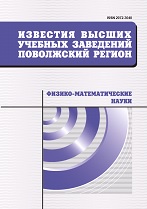|
|
University proceedings. Volga region. Physical and mathematical sciences, 2013, Issue 3, Pages 136–145
(Mi ivpnz398)
|
 |
|
 |
Physics
The calculation of the efficiency of batteriesbased on microchannel silicon and nickel-63 as a beta-source
I. Nagornov
Togliatti State University, Togliatti
Abstract:
Background. Semiconductor devices of the new generation require miniature sources of electric power that work for quite a long time and have small dimensions. The introduction of planar structures with radiation-stimulated batteries is possible in the area where traditional sources of energy are not available. For example, gas leak detectors in mines, deep-water control elements, underground sensors, etc. In this regard, the development of an effective and commercially attractive source of energy based on beta sources is an urgent task. Nickel-63 as a beta source has a very long half-life (100.1 years) and relatively high activity, so the use of nickel isotope will create fundamentally new planar elements and sensors. One of the most interesting ways of increasing efficiency is the use of microchannel silicon, into the pores of which a beta source is placed. The present work is devoted to the calculation of the efficiency of batteries based on microchannel silicon and nickel-63 as a beta- source. Materials and methods. The following model of microchannel radiation-stimulated current source is accepted in the paper. Channels in silicon extend along the entire sample, which is technologically easier to create and does not change the calculation logic. Thus all channels have the same depth h and the width l , and periodically spaced apart by the distance m . It is clear that the most effective structures will contain the most profound channels, so this option can be excluded from the selection, taking h equal to 400 $\mu$m which is the maximum depth available in the modern technology. At present, the ratio of width / depth is also determined by etching technology, but in our calculations we assume that they are independent, as the technology of ion and electrochemical etching is developing quite quickly. The method for calculating the generation current is numerical. Results. The task of calculating the efficiency is multi-parameter, so for the analysis of the results current generation versus structure parameters were plotted down. Dependencies of current generation on microchannel silicon geometric parameters were obtained. The optimum channel width l was found to be about 2.5 $\mu$m, while current generation saturation is registered when the distance between the channels m increases. In terms of efficiency the optimal parameters of the model structure are the microchannel width equal to 2.5–3 $\mu$m and channel spacing equal to 10–12 $\mu$m. Conclusions. The possibility of the creation of radiation-stimulated batteries based on microchannel silicon with a beta-source placed into the microchannels was considered. Nickel-63 with the activity of 40 mCi/cm${}$ was taken as a beta-source. The technological readiness of modern production to create similar structures based on vertical p-n junctions was shown. The calculation of efficiency of these structures showed that generation currents could be achieved at 1600 nA/cm${}$ that was 20 times greater than the same index in monocrystal structures.
Keywords:
betavoltaic effect, battery efficiency, microchannel silicon, macroporous silicon.
Citation:
I. Nagornov, “The calculation of the efficiency of batteriesbased on microchannel silicon and nickel-63 as a beta-source”, University proceedings. Volga region. Physical and mathematical sciences, 2013, no. 3, 136–145
Linking options:
https://www.mathnet.ru/eng/ivpnz398 https://www.mathnet.ru/eng/ivpnz/y2013/i3/p136
|

| Statistics & downloads: |
| Abstract page: | 15 | | Full-text PDF : | 8 | | References: | 6 |
|




 Contact us:
Contact us: Terms of Use
Terms of Use
 Registration to the website
Registration to the website Logotypes
Logotypes








 Citation in format
Citation in format 